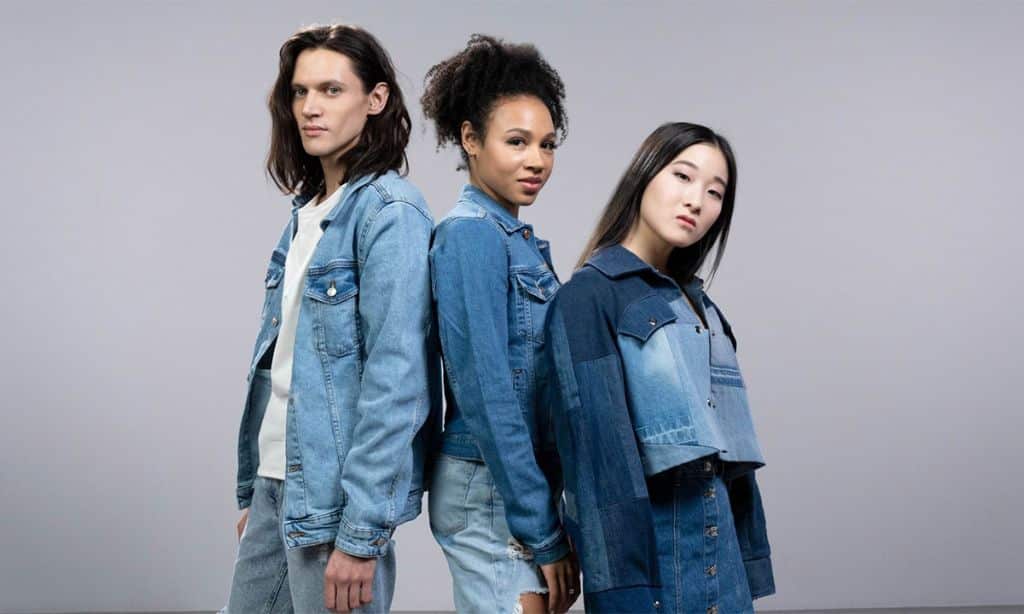Ever wondered what your jeans would say if they could talk?
From rebellious teens to astronauts in space, denim has seen it all. Your favorite pair isn’t just fabric—it’s a time machine!
Ready to unzip 30 fascinating facts about denim? Did you know the blue stuff that’s older than your great-grandpa and cooler than any TikTok trend? Let’s dive into the wild world of denim!
The Mind-blowing History of Denim
Denim’s storied history begins in the bustling textile workshops of 17th-century Nîmes, France, where skilled weavers first created a durable fabric called “serge de Nîmes,” eventually shortened to “denim.”
This sturdy cloth quickly gained a reputation for its resilience and versatility. Meanwhile, in Genoa, Italy, another city with a rich maritime tradition, sailors wore tough cotton trousers known as “jeane” or “jean,” after the Italian word for Genoa, “Genoá.”
The fabric’s distinctive blue color comes from the Indigofera tinctoria plant, native to India, whose natural dye transforms the cloth from green to blue as it oxidizes. By the 18th century, denim had become the fabric of choice for laborers due to its unmatched durability, setting the stage for its evolution from a workwear staple to a global fashion icon.
30 Fascinating Facts About Denim
Discover the rich history and surprising details behind denim, how the fabric has evolved from sturdy workwear to a global fashion staple. Here are 30 intriguing facts that showcase its journey and enduring popularity.
- The Nîmes Connection: Ever wondered where the word “denim” comes from? It’s a tale of two cities! “Denim” is short for “serge de Nîmes,” meaning “serge from Nîmes.” Nîmes, a city in southern France, was the birthplace of this sturdy fabric. Imagine the bustling textile workshops of 17th-century France, where skilled weavers first created this tough, durable cloth!
- Italian Roots: While we often think of denim as all-American, its true origins lie in Genoa, Italy. The fabric was originally called “jeane” or “jean,” after the Italian word for Genoa, “Genoá.” Picture Italian sailors in the 1500s, wearing tough cotton trousers made from this new fabric as they navigated the Mediterranean.
- The Magic of Indigo: What gives denim its iconic blue color? It’s all thanks to a plant called Indigofera tinctoria, native to India. For centuries, cloth dyers used this natural indigo to create that perfect blue hue. The dyeing process was like magic—the fabric would emerge from the dye vats green, only turning blue as it oxidized in the air!
- Tough Stuff for Tough Jobs: Denim wasn’t always a fashion statement. In the 18th century, it was prized for its durability. Miners, farmers, and other laborers relied on jeans clothing to withstand the wear and tear of their demanding jobs. Imagine a gold miner in the 1850s, his denim overalls covered in mud but still holding strong after months of hard work!
- Levi Strauss: The Denim Pioneer: In 1853, a young Bavarian immigrant named Levi Strauss arrived in San Francisco during the California Gold Rush. He didn’t strike gold in the traditional sense, but his dry goods store would soon lead to a different kind of treasure. Little did Strauss know that his name would become synonymous with blue jeans!
- The Birth of Blue Jeans: The eureka moment for modern jeans came in 1872. Jacob Davis, a tailor and customer of Levi Strauss, had a brilliant idea. He started using copper rivets to reinforce the pockets of work pants, making them even more durable. Davis partnered with Strauss, and in 1873, they patented this revolutionary design. Can you imagine the excitement when miners discovered these super-strong new pants?
- The Legendary 501: In 1890, Levi Strauss & Co. introduced the 501 jean – a design that would stand the test of time. These jeans, with their button fly and riveted pockets, quickly became a favorite among workers. Today, more than 130 years later, you can still buy a pair of 501s. It’s like wearing a piece of history!
- Denim Goes to War: During World War II, denim played a crucial role on the home front. The U.S. government declared it an essential commodity, limiting its use to military purposes and defense worker uniforms. Factories churned out denim uniforms, and the tough fabric proved its worth in the harshest conditions. Even off-duty soldiers often chose to wear their denim when relaxing!
- James Dean’s Rebel Style: In 1955, James Dean starred in “Rebel Without a Cause,” and denim would never be the same. His character, Jim Stark, wore blue jeans in a way that captured the spirit of youth rebellion. Suddenly, denim wasn’t just for workers—it was cool, edgy, and a symbol of teenage defiance. Imagine the shock of parents when their kids started clamoring for this “workwear” as fashion!
- Singing the Blues: Music and denim have always had a special relationship. In 1979, Neil Diamond released “Forever in Blue Jeans,” a song that celebrated the simple joys of life—including a good pair of jeans. But this wasn’t the first or last time denim starred in music. From blues singers to rock stars, musicians have been singing about (and wearing) jeans for decades.
- Presidential Denim: Even presidents aren’t immune to the allure of denim! Levi Strauss & Co. paid a whopping $25,000 in 1997 to repurchase a pair of Levi’s 501 jeans from the 1920s that had once belonged to a Nevada miner. This set a Guinness World Record for the most expensive pair of jeans. Imagine owning a pair of jeans worth more than a car!
- Out of This World: In 1969, as Neil Armstrong prepared to take one giant leap for mankind, Levi Strauss was busy designing something special. They created custom white denim suits for the Apollo 11 astronauts to wear during their downtime on the spacecraft. Talk about the ultimate casual Friday outfit!
- The Accidental Stonewash: Sometimes, the best discoveries happen by accident. In the 1950s, someone accidentally washed a pair of jeans with pumice stones, creating the first “stonewashed” look. This happy accident led to a whole new way of treating denim, giving jeans that worn, lived-in look that became hugely popular in the 1980s.
- Stretch It Out: In 1962, Wrangler revolutionized the denim world by introducing the first stretch jeans. By blending denim with synthetic fibers, they created jeans that moved with you. Imagine the joy of being able to actually bend down in your jeans without fear of splitting a seam!
- Laser Focus: Modern denim production is like something out of a sci-fi movie. Many companies now use laser technology to create intricate designs and distressed looks on jeans. This isn’t just cool – it’s also more environmentally friendly, reducing water usage and chemical treatments. Picture a laser carefully etching a worn pattern onto a pair of jeans in seconds!
- Green Jeans: The denim industry is going green! In recent years, companies have developed more sustainable indigo dyes and dyeing processes. Some use natural indigo, while others have created synthetic dyes that mimic the properties of natural indigo but with less environmental impact. There are even jeans made from recycled plastic bottles!
- Japanese Denim Artistry: In the 1970s, Japan emerged as a powerhouse in high-quality denim production. Japanese artisans combined traditional techniques with modern technology to create some of the world’s most sought-after denim. Imagine vintage shuttle looms clacking away, producing narrow bolts of perfectly imperfect selvage denim!
- China’s Denim Dominance: Today, China is the world’s largest producer of denim, accounting for nearly 50% of global production. The scale of Chinese denim manufacturing is mind-boggling – think of vast factories producing millions of pairs of jeans each year, enough to clothe entire nations!
- India’s Indigo Legacy: India, the original home of indigo, continues to play a crucial role in denim production. Not only does it produce large quantities of denim fabric, but it’s also a major source of indigo dye. The country’s centuries-old tradition of indigo cultivation and dyeing continues to influence modern denim production.
- Turkish Delight: Turkey has become a major player in the denim world, known for its high-quality fabrics and innovative techniques. Turkish mills are at the forefront of developing sustainable denim production methods, including using recycled materials and reducing water consumption.
- A Billion-Dollar Blue: The global denim market is huge and growing. In 2022, it was valued at about $64.5 billion. Experts predict it could reach $88.1 billion by 2030. That’s a lot of jeans!
- Jean Genie: On average, Americans own seven pairs of jeans each. Some people have way more—are you one of them? Count your jeans and see how you stack up!
- Thirsty Fabric: Making a single pair of jeans can use up to 1,800 gallons of water. That’s enough to fill a small swimming pool! This includes water used in cotton production and all the washing and finishing processes.
- Weighty Matters: Denim fabric is measured by weight, in ounces per square yard. Lightweight summer jeans might be 5-6 oz, while heavy-duty winter jeans could be 16 oz or more. The heaviest denim can be over 32 oz – that’s like wearing armor!
- The Case of the Missing Rivets: During World War II, jean manufacturers had to remove the rivets from back pockets and watch pockets. Why? To conserve metal for the war effort! This small change shows how even fashion had to adapt during wartime.
- The End of an Era: For over 100 years, Levi’s sourced denim from the Cone Mills White Oak plant in North Carolina. This historic mill closed in 2017, marking the end of a chapter in American denim history. Denim enthusiasts around the world mourned the loss of this iconic source of American-made denim.
- Denim with a Message: April 28th is Denim Day in the United States. It’s not a celebration of fashion, but a powerful statement against sexual violence. People wear jeans on this day to support survivors and challenge myths about sexual assault.
- The Secret in the Selvedge: Ever noticed that line on the cuff of some jeans? That’s the selvedge edge, a sign of denim made on old-style shuttle looms. This edge was originally created to prevent fraying, but now it’s a mark of quality sought after by denim aficionados.
- Presidential Jean Controversy: In 2009, President Barack Obama caused a stir when he wore what critics called “mom jeans” to throw the first pitch at an All-Star Game. The incident sparked a national debate about men’s fashion and what constitutes appropriate jean styles for different occasions.
- Jeans in Space: In 2013, Italian company Tron Designs created the first pair of jeans specifically designed for space travel. These high-tech trousers featured special pockets for space pens and anti-bacterial properties to stay fresh in the closed environment of a spacecraft. Who knows—maybe astronauts on Mars will be wearing denim one day!
Key Moments in Denim History: A Timeline
As we’ve journeyed through the fascinating history of denim, you’ve seen how this humble fabric has evolved from workwear to a global fashion phenomenon. To help you visualize this incredible timeline, we’ve put together a table of key moments in denim history.
Let’s take a look at these game-changing moments:
| Year | Event | Impact |
| 1873 | Levi Strauss and Jacob Davis patent riveted work pants | Birth of modern blue jeans |
| 1890 | Levi’s 501 jeans introduced | Iconic style still produced today |
| 1950s | Stonewashed jeans accidentally discovered | New aesthetic for denim |
| 1962 | Wrangler introduces first stretch jeans | Increased comfort and flexibility |
| 1969 | Levi’s designs denim suits for Apollo 11 astronauts | Denim goes to space |
| 1970s | Japanese denim production gains renown | Premium denim market emerges |
| 2017 | Cone Mills White Oak plant closes | End of an era in American denim |
| 2022 | Global denim market valued at $64.5 billion | Denim’s continued economic importance |
This table highlights some of the most pivotal events that have shaped the denim industry and its cultural impact over the past 150 years. From the birth of blue jeans to the modern global market, each entry represents a significant milestone in the story of denim.
Takeaways
Next time you pull on your favorite pair of jeans, take a moment to appreciate the centuries of history, innovation, and culture woven into that familiar fabric.
Whether you’re a fashion enthusiast or just someone who loves the comfort of a well-worn pair of jeans, you’re part of the ongoing story of denim.












































